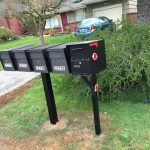A few months ago I listened to a How I Built This episode about the Dripsie, a meticulously and carefully designed sink strainer. I have a garbage disposal in the bottom of our single bowl kitchen sink and thus have no need for a Dripsie. I bought a two-pack anyway and took them up to our ski lodge to try them out.
They work much better than the old stainless strainers full of little holes. Even when they’re full up with food scraps, they continue to drain very well. Tonight Alicia asked me where I got them. At first I couldn’t remember and googled a few terms related to sink strainers with no luck at all. Then I finally remembered the name Dripsie and voila.
Tag: home
tankless water heaters
I just wrote this for a neighbor and am cross-posting it publicly here.
I’ve installed a couple of the EcoSmart models. When I installed them last year, Lowes stocked them. Today I see Lowe’s only stocks the Eemax (no experience) but now Home Depot stocks the EcoSmart. The only complexity on them is sizing: with traditional (gas or electric) the “standard” size is 40 gallons. For heat pump heaters, the “standard” is 50 gallons because they have a slower recovery time.
For tankless models, they are sized by flow rate and inlet water temperature. An example would be the 3.5GPM model. It would be sufficient to provide two simultaneous “fixtures” (think: shower + kitchen sink) with straight hot water (assuming low-flow fixtures) when the water comes out of the ground at 52° (summer/fall). In the winter when the ground and water is colder, it might not get the water all the way to 110° at flow rates higher than about 2GPM. That would be a bummer if you live with someone that wants to wash the dishes while you’re showering. So spend the extra $80 and get the 5GPM model.
The major usability difference between tank and tankless is that in practice, with a tank you get hot water for about 40 gallons + the recovery rate of the heater. That means about 50 gallons of hot water and then it starts getting progressively colder. In a family environment, that means: take your shower first. And install low-flow fixtures. With a tankless heater, the last shower is the same temperature as the first. It heats the inlet water up to your set point in real time, for as long as the hot water runs.
A tankless electric heater is about 15% more efficient than an electric tank heater because it has no standby losses. Also, if you tank is 3 miles from your fixtures, the tiny size of a tankless model means you can consider relocating the heater closer to the bathrooms(s) and/or kitchen where most of the water is used. That’s less pipe to warm up, less water down the drain, and less waiting for hot water. You can even go Euro with one small unit under the kitchen sink and another to service the bathrooms.
A downside is that you’ll likely need to install one (3.5GPM) or two (5GPM) additional 40A electrical circuits for a tankless model.
Solar ROI update
I now have a full year of electric production and consumption measured. I also have the SCL rate updates for 2017 and 2018 so I have updated my solar ROI estimates. The significant change is that the Net Metering benefit has substantially increased due to:
- SCL electric rates are higher in Shoreline than Seattle.
- The 2017 and 2018 rate increases are 5.6% (estimated at 4%)
- An added RSA surcharge of 1.5%
- The coldest winter in 32 years
- More electricity use than I predicted.
- I was still insulating deep into the heating season.
- I guesstimated the kWh it would require to heat a 1955 house with heat pumps.
- I installed a fast (level 2) charger for our Leaf. We were able to use it more, offsetting gasoline with electricity.
- The increased usage is all at the higher 0.14¢ price tier.
Reasons 1-4 weren’t known during my initial estimates. Reasons 5 and 6 were planned but their scale was unknown. I knew I’d be removing all natural gas appliances (furnace, water heater, fireplace) but I hadn’t yet decided whether to install tankless electric or a heat pump water heater. I hadn’t chosen the heat pumps for house heat yet so I didn’t know their HSPF. I also didn’t know how much more we’d be able to use the Leaf.
The net result is that I now estimate a 100% return on the solar array in the 6th year instead of the 8th year.
Notes
- I did not include the cost of the heat pumps or the heat pump water heater. Those were efficiency upgrades that I’d have done anyway. If I were keeping natural gas, I’d have replaced the old 80% furnace with a 97% modulating furnace and the “well past its expected lifespan” gas water heater with a gas tankless. In both cases the costs are comparable and just like replacing the fridge, the efficiency increases have their own ROI schedule.
Mail Boss mailboxes
Mail Boss


You must be logged in to post a comment.